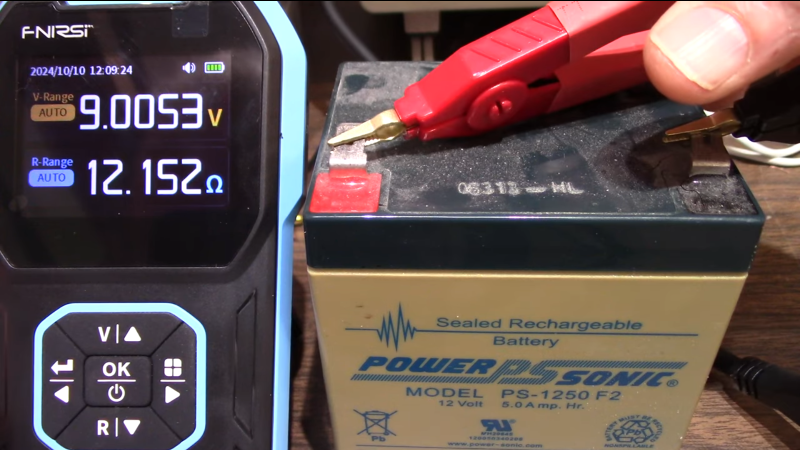Occasionally, we find fun new electronic instruments in the wild and can’t resist sharing them with our readers. The item in question is the FNIRSI HRM-10 Internal resistance meter, which we show here being reviewed by [JohnAudioTech].
So what does it do, and why would you want one? The device is designed to measure batteries so you can quickly determine their health. Its operating principle also allows it to do a decent job of measuring low-resistance parts, which is not necessarily as easy to achieve with the garden variety multimeter, especially the low-end ones. We reckon it would be useful in the field for checking the resistance of switches and relays, possibly in automotive or industrial applications. The four-pin connector is needed because there are two wires per probe, making a Kelvin (also known as four-wire) connection.
Likely, the operating principle is to apply a varying load to the battery under test and then measure the voltage drop. The slope of the voltage sag vs load is a reasonable estimate of the resistance of the source, at least for the applied voltage range. The Kelvin connection uses one pair of wires to apply the test current from a relatively low-impedance source and the second pair to measure the voltage with a high input impedance. That way, the resistance of the probe wires can be calibrated out, giving a much more accurate measurement. Many lab-grade measurement equipment works this way.
Circling back to the HRM-10, [John] notes that it also supports limit testing, making it a helpful gauging tool for the workbench when sorting through many batteries. Data logging and the ability to upload to a computer completes the feature set, which is quite typical for this level of product now. Gone are the days of keeping a manual logbook next to the instrument stack and writing everything down by hand!
We’ve touched on measuring battery internal resistance before, but it was a while ago. Regarding Kelvin connections, here’s a quick guide and a hack upgrading a cheap LCR to support 4-wire probes.















Nifty!
what is the price?
45-80 USD
I have seen too many fnirsi stuff that simply does not work properly, and the manufacturer grossly lying and exaggerating the specifications, that I stopped even watching reviews. Reviewers of fnirsi stuff are also often relative beginners and don’t always recognize the gaping lies in the fnirsi equipment. Prices are cheap, and the stuff looks good, but were does that get you if it does not work properly? Even Matthias Wandel does not like the fnirsi scope he got for free. I remember a screenshot from a youtube video where a fnirsi component tester looses it in capability from the ubiquitous transistor tester.
I understand that Hackaday does not want (too many) negative reactions, but the fnirsi stuff is deceptively misleading because of it’s good looks, and low price and it especially appeals to beginners who only too late find out it is under performing and not even living up to the specified specifications.
Thanks for the info. Important info!
Maybe you can let us know which Fnirsi devices you have personally tested that don’t meet their specs. It would save us all a lot of frustration.
You dont have to look all that hard to find pretty egregious examples of typical Fnirsi fraud
https://hackaday.com/2023/05/11/fnirsi-vs-rigol-an-alternate-view/
https://hackaday.com/2022/06/07/cheap-oscilloscope-is-well-cheap/
https://hackaday.com/2020/07/09/tablet-oscilloscope-claims-100-mhz-but-is-it/
30MHz BW instead of claimed 100MHz, 2x 100MHz ADC instead of claimed 1GSps
Well, that’s too harsh a verdict. The scope is usable, with the additional advantage of being portable. The HRM-10 exceeds some of the manufacturer’s specs. For example, 1k can be measured reliably with that meter. Ever tried to measure resistance in the mOhm range? This thing can at least give you an idea. And that stuff is dirty cheap.
Which devices are those, then? You’ve only mentioned some scope and if you’re just extrapolating from a single device and jumping to the conclusion that all of their products must therefore be bad, you’re being quite unfair and short-sighted.
The aesthetics are better than even some high end brands, I’m surprised other brands aren’t doing more to compete looks.
Maybe it’s a good thing though, if that would take away from the budget to make them actually work well. Although Owon does a pretty good job of both.
More like fashion, with beveled corners everywhere and a “D” pad instead of separated buttons. Thankfully they don’t play with dull functional instruments.
FNIRSI, not FILMSY
I also made a video on this instrument where it held up against a HP 4338B
It was well within speck and worked quite well.
After the video I calibrated it myself and it was even better.
https://www.youtube.com/watch?v=5i6QKBgfADs
Nothing wrong with the HRM-10. Clear menus, many options, firmware upgradable and calibration options for voltage and resistance. Calibration is not really needed as it is already in spec from factory.
A Kelvin probe should be properly used and not with the clamps closed against the poles of an AA battery as this compromises the results. It would have been nice if dual pogo pin probes were included in the box for situation wher the clamps are a little troublesome. But that is the only minor shortcoming of this product.
By any chance does anyone know what connector the kelvin probe uses?
GX12, 4 Pin, Single Female Head